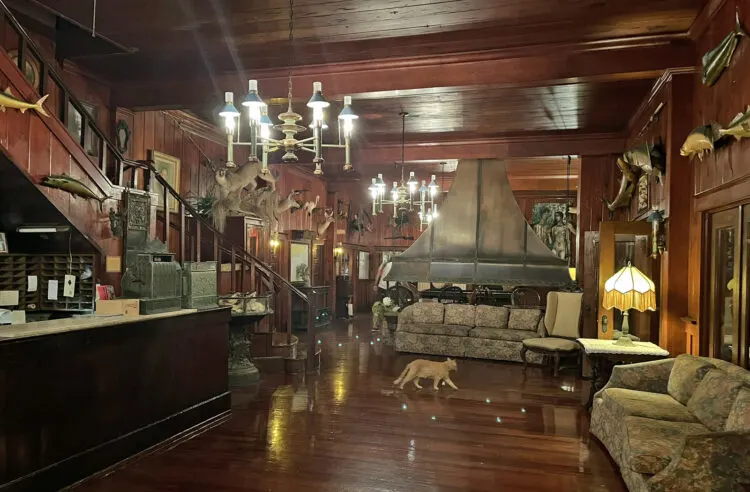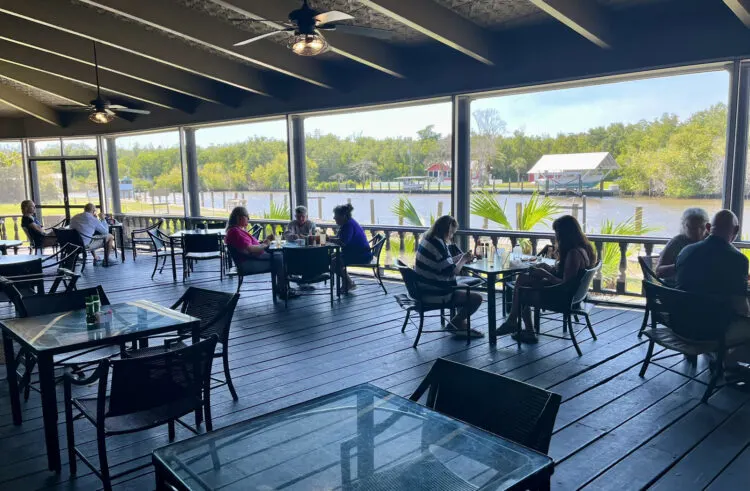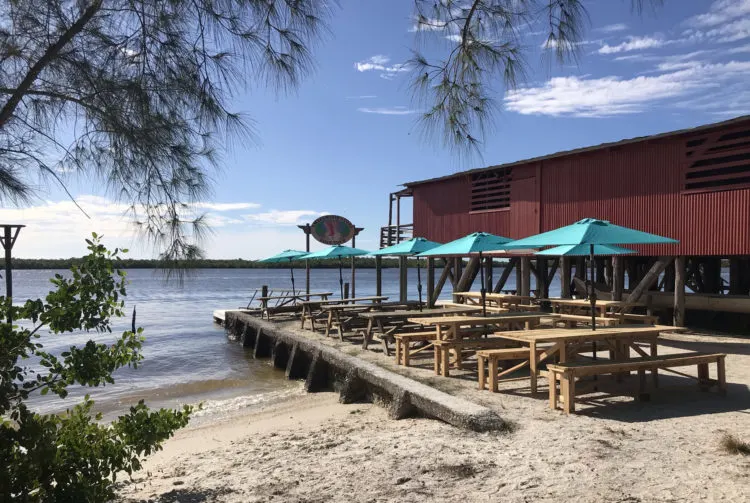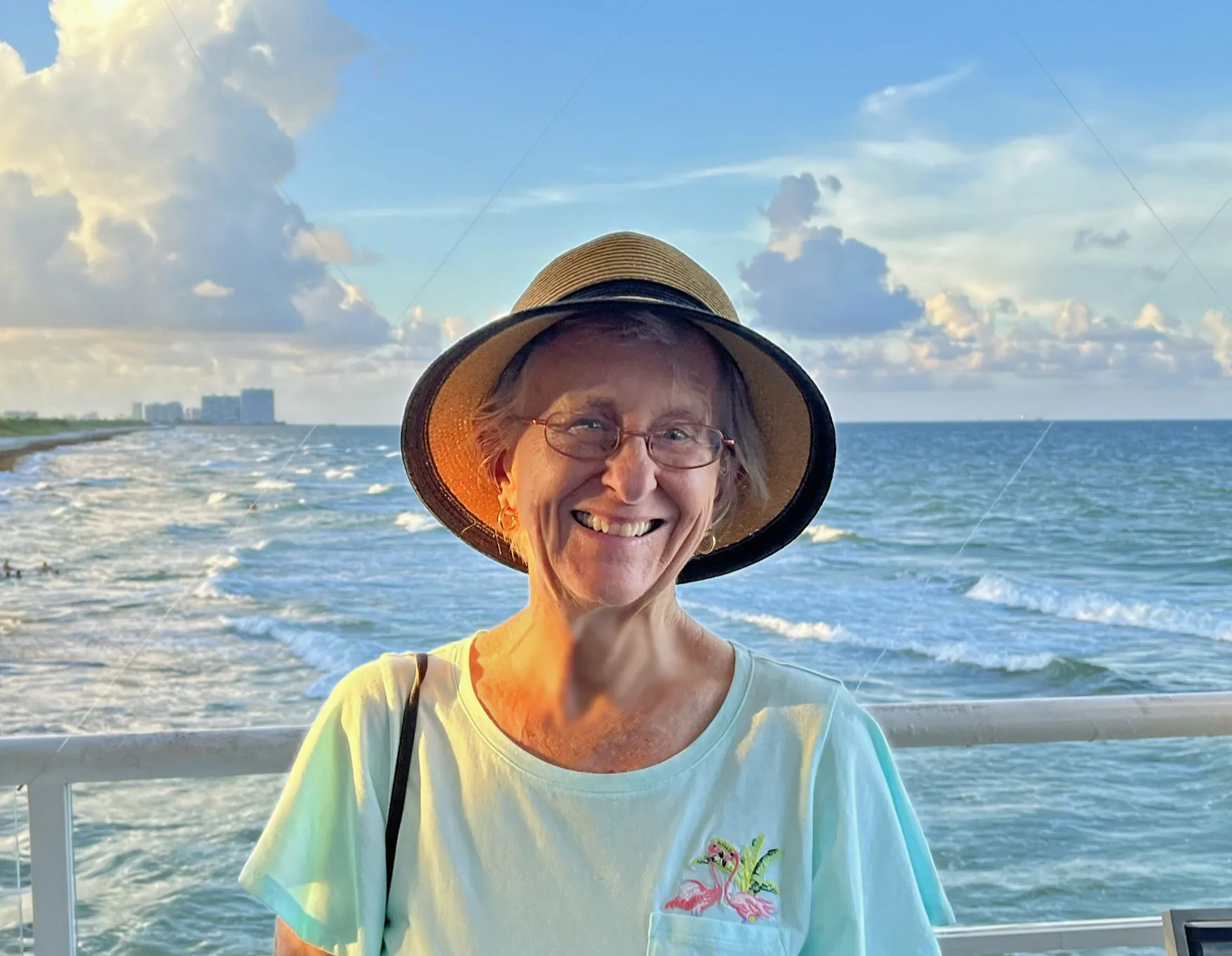Everglades City has a romantic “end of the road” aura.
It’s a place surrounded by water and wilderness with a tiny population that keeps rebuilding as the place is blasted by hurricane after hurricane. It’s full of surprising stories, history and beauty.
For visitors, Everglades City is also a great place to kayak, fish, see wildlife, explore parks, and eat stone crabs.
If what catches your attention is stone crabs, then be sure to visit Oct. 15 to May 1, when the lobster-like crustaceans are on the menu. That’s also the best time for outdoor Everglades activities.

Everglades City is an hour south of Naples and less than two hours west of Miami. We’ve visited as a day trip from Fort Lauderdale.
I think three days and two nights is the perfect length of time to visit Everglades City, have a substantial outdoor experience, and get to know the town a bit. You can have a great time with one overnight, however, especially if it’s a stone-crab pilgrimage.
I’ve created this itinerary to suggest how to spend your time.
Day 1: The drive to Everglades City is full of things to do
If you’re driving from the Atlantic Coast, you can choose from interesting stops along the Tamiami Trail. The road’s name is pronounced tammy-ammy and derived from Tampa-Miami, the two cities it joined. (If you’re driving from Naples, at some point you may want to drive an hour east on the Tamiami Trail to experience the things I suggest. I’m basing this itinerary on arriving from the east.)

Stops along the Tamiami Trail
As you approach Everglades City on the Tamiami Trail, you have an opportunity to stop at one of the best places to experience the Everglades, Shark Valley. It’s 45 minutes east of Everglades City, so it’s ideal to stop on your way there.
Shark Valley is one of three main entrances to Everglades National Park and it consists of a single 15-mile paved road, open only to guided tram tours, bicyclists and those on foot. In winter, it is full of wildlife that is so close you may have to work to evade it. Alligators, for example, may sun on the paved road where you are walking or biking. Shark Valley also attracts many wading birds.
Any way you choose to see Shark Valley – tram tour, walking or renting a bike and riding – provides a good experience. Personally, I love the bike ride. See a Florida Rambler story all about visiting Shark Valley.
Between Shark Valley and Everglades City, the Tamiami Trail offers several other places to stop, and if you skip Shark Valley, you’ll still have chances to see alligators and birds and Everglades scenery.

I recommend you make your next stop at Clyde Butcher’s Big Cypress Gallery, 52388 Tamiami Trail E, Ochopee. Butcher is a renowned photographer whose large-scale black-and-white photos are designed to make viewers feel like they are at the center of the scene captured. His photos help visitors appreciate the subtle beauty of this unique ecosystem.
Butcher’s studio overlooks a scenic pond, where alligators and wading birds are frequently seen. Be sure to take the short walk on a trail on the grounds.
From the gallery, as you head west, the Tamiami Trail passes through the Big Cypress National Preserve and is designated as a scenic highway. There are several locations here to park, see wildlife, take a hike or have a picnic.

Consider stopping at the Big Cypress National Preserve Visitor Center, 52105 Tamiami Trail E, Ochopee,where there are exhibits, an introductory film and national park staff available to answer questions. The boardwalk out front overlooks a pond that attracts gators in winter and rangers periodically give informative talks here. Read more about your choices in this Florida Rambler Tamiami Trail guide.
A few miles further, you can stop for a picnic or to use the restrooms at H.P. Williams Picnic Area, 12580 Turner River Road, Ochopee, where alligators and wading birds are often seen from a short boardwalk.
Watch for the tiny very cute post office at 38000 Tamiami Trail E, across from the historic (1928) Joanie’s Blue Crab in “downtown Ochopee” and pause to admire it if you have the time.

Arriving in Everglades City
If you arrive early enough, start with the small but excellent Museum of the Everglades, 105 Broadway Ave. W, Everglades City. It’s free and it’s a great way to get oriented and learn Everglades City’s colorful history in 30 to 45 minutes. (It closes at 4 p.m. and is closed Sunday and Monday.)
You’ll learn how Barron Collier, who made his millions with the brilliant innovation of selling advertising on street cars, invested in this mosquito infested corner of Florida at a time when there were no roads. He had to build a highway from the East Coast: the Tamiami Trail, which was considered a modern miracle.

My favorite artifact at the museum dates from the opening of the Tamiami Trail, when Collier knew that people needed to be reassured they could safely cross this wilderness. He built four gas station/convenience stores and created his own police force to patrol the highway.
Troopers rode spiffy Harley Davidson police motorcycles – a rare 1929 model has been restored for display at the museum. Officers wore bright red jackets, inspired by the Canadian Mounties, a copy of which you’ll see on the manikin on the motorcycle.

Another exhibit not to miss is about Everglades City’s hurricane history. Look for the two locations in the museum where there are signs showing how high the water was inside the museum during Irma in 2017. Irma was the worst of the recent storms, but there have been many over the years.

Dinner on your first night: the Everglades City Rod and Gun Club
The ups and downs in Everglades City are dramatic, and they explain why the Everglades City Rod and Gun Club is such a historic treasure.
City founder Barron Collier took an existing home that served as a hotel and added on, turning it into an upscale rustic lodge in 1922. It was a classy spot, befitting Collier’s status and the cronies he entertained there. In 1947, it was where President Harry S. Truman attended a luncheon celebrating the opening of Everglades National Park.
But in 1960, devastating Hurricane Donna hit Everglades City hard and the glory days were over. The bank, the county seat and even Collier’s company all moved to Naples. A family bought the Rod and Gun Club in the ’60s and still owns it. There apparently was no development pressure in Everglades City, so the Rod and Gun Club aged undisturbed, stayed in business and miraculously survived storm after storm.

I was happy to see that the restaurant at the Rod and Gun Club had a good crowd and offered excellent food and service on our April 2024 visit. I am happy to be able to again recommend it. (But bring cash; no credit cards are accepted.)
Dine here, but don’t be quick about it. Look at everything in the remarkable lobby. Read the yellowing newspaper clippings in the entryway. Poke your head into the gorgeous peck cypress bar (rarely used now) off the lobby. It’s better than a museum. Here’s a Florida Rambler story on the Rod and Gun Club.

Day 2: Plan your Everglades outdoor adventure
During your full day in Everglades City, you have many options that will get you outdoors, enjoying this unique environment.
Kayaking with Everglades City as a base
There are some excellent kayak trails in the vicinity and there are several outfitters who will rent you kayaks or offer guided eco-tours. (You’ll find outfitters in the linked articles.)
I think the Turner River is my favorite Everglades river because, unlike most trails, where you choose either cypress swamp or mangrove or sawgrass environments, the Turner River takes you through it all – with over-the-top scenery and wildlife too. Here’s a Florida Rambler story on kayaking the Turner River.
If you decide on the Turner, keep in mind that to maintain the environment and avoid congestion, outfitters are limited in how many kayaks they can launch on the Turner each day, so you need to reserve ahead. If you bring your own kayak, the parking lot can fill up, so early mornings are your best time to start.

When the Turner is too low on water or too crowded, a nearby trail is a good alternative: Halfway Creek trail. It’s full of magnificent airplants and allows you to arrange a trip of any length.
A third kayak option is to paddle into one of the closest of the Ten Thousand Islands. A great saltwater kayak trail nearby is Sandfly Loop, which gives you a taste of the Ten Thousands Island.

Not a kayaker? You have several other excellent boating options
Probably the most popular activity in Everglades City is to take the naturalist-led Ten Thousand Islands tour operated by a concessionaire of Everglades National Park. The covered pontoon boat goes into the Ten Thousand Islands and often spots dolphins plus many birds and other wildlife. While the park’s Gulf Coast Visitor Center is being rebuilt in 2024 (Hurricane Ian damage), the boat tour is operating from another location in town. Tickets are $48 for adults.
Many people also think a ride on an airboat is an essential Everglades experience, and Everglades City is a great place to do that. Airboats aren’t my thing, so I can’t offer guidance here, but you’ll find several to choose from and you can read reviews online.
Similarly, I am not a fisherman, but the fishing is famous in Everglades City. A very popular activity is hiring a guide to give you a great fishing experience.

Spending the day on land seeing the Everglades City environment
On your second day, if you haven’t visited the Museum of the Everglades, consider doing this now. Afterwards, walk around town and read the many historic landmark signs.
One of my favorites is in the median strip where Broadway meets the Barron River. (It’s next to the Rod and Gun Club.) Here, we were amazed to read there was a streetcar line back in the day! There is also a historic goldfish pond, restored by Eagle Scouts at one point. But it was impossible to keep goldfish in it; the raccoons got them. Nearby is the historic boat lift which was “transformed into a work of art” by Kenneth Noland, a prominent American color-field artist.

For lunch, consider City Seafood, one of two excellent rustic seafood restaurants specializing in stone crabs and other local catches. It’s located right on the docks, with open air picnic tables with a great view. It’s not open for dinner.
If you are enchanted by out-of-the-way historic spots, you definitely want to stop at Smallwood Store on Chokoloskee, four miles away. Admission to this authentic well-preserved 1906 general store, listed on the National Register fo Historic Places, is only $5

Its dock is a lovely place to watch the sunset. Also, for $10 you can launch your kayak here and paddle out to the closest of the Ten Thousand Islands. Here’s a Florida Rambler story on the historic Smallwood Store.
On your way to Chokoloskee Island, if you want to get an aerial view of area, there is a newly rebuilt wooden tower with 108 steps to the top, where you can gaze over the Ten Thousand Islands. It’s $5 per person.
Right now, it’s the best view of the work being done to rebuild the visitor center and docks at Everglades National Park’s Gulf Coast Visitor Center, which won’t re-open until next year. The visitor center was destroyed in Hurricane Irma in 2017 and then the temporary quarters were wrecked in Hurricane Ian in 2022.

Dinner on Day 2: Triad Seafood or Camelia Street Café
There are only a few places to eat in Everglades City, but thankfully, the options are excellent. Everglades City is known as Florida’s Stone Crab Capital. The season is Oct. 15 to May 1.
Triad Seafood, 401 School Dr. W, is the place people come from all over the world to feast on stone crabs and other fresh seafood. Triad serves a great variety and we can also recommend the fried-conch sandwich. It comes with fresh herb-seasoned fries and coleslaw. The sweet potato fries were great, too.
Stone crab prices vary during the season and a low harvest meant high prices. You can count on your least expensive stone crab dinner being at least $40 and $60 for jumbo at Triad, where dinners come with two side dishes and hush puppies. Triad at times offers an all-you-can-eat option at market prices, which can vary.

Camellia Street Grill, 202 Camellia St., is another open-air spot on the Barron River where we’ve had excellent food. Locals recommend it too. The tin-roofed restaurant has live music on some nights You’ll know you’re there when you see the colorful VW Beetle at the curb. The views here are terrific and the ambiance is fun. Our vegetarians raved about the veggie burgers, and it offers plenty of fresh fish options, including Florida stone crabs, as well as lots of taco options.
Day 3: Before you leave, a few more places to explore
For breakfast, we recommend the small-town-feeling of Island Café, 305 Collier Ave., which is also an option for a casual dinner in an old-school diner.
Then work off those calories with a hike at one of three nearby spots:
Collier Seminole State Park, 20200 E. Tamiami Trail, is on the route toward Naples, so if that’s the way you’re going, this is a good destination. The park is home to the 1924 Bay City Walking Dredge, and how often do you get to visit a “National Historic Mechanical Engineering Landmark”? The hulking dredge was used to build the Tamiami Trail, a road across the Everglades only possible because of this amazing contraption. There are also several hiking trails here, most notably one that goes by a rare stand of native royal palms. Here’s a Florida Rambler story on Collier Seminole State Park.

Minutes from Collier-Seminole, Fakahatchee Strand Preserve State Park is the biggest state park in Florida. It’s great to explore on foot with dry, easy-to-walk trails through a vast and beautiful cypress forest filled with air plants and wild orchids. (Some visitors are lucky enough to spot Florida panthers here.)
A perfect hike is an easy stroll down East Main Trail to a private cabin that makes a great turn-around destination on a two-hour hike. It’s a small, rustic building of old wood and corrugated metal with a sign at the front door proudly identifying it as the Fakahatchee Hilton. Here’s a Florida Rambler story on Fakahatchee Strand Preserve State Park.
If you only have a short time, a good stop is the Big Cypress Bend Boardwalk at Fakahatchee Strand, 27020 Tamiami Trail E, Naples. It’s part of the state park but located outside the main entrance. It’s on the Tamiami Trail on the way to Collier Seminole State Park and Naples.
The recently opened boardwalk replaces a hurricane-ravaged one that wound through a lush cypress swamp. This replacement takes you through a sunny prairie. There’s a spectacular open air pavilion over the prairie with a breeze and rocking chairs. This boardwalk features restrooms.

Where to stay in Everglades City
We’ve been staying at the Ivey House Everglades Adventures Hotel, 107 Camellia St. E, Everglades City, for a long time, including in the funky historic wing now gone due to Hurricane Irma. The Ivey House is associated with a kayak outfitting company, so you can book your kayak out and your room here. There’s a pool too. Here’s a Florida Rambler story on Ivey House Everglades Adventures Hotel. Rates start at $145 but are higher at peak times.
We’ve not stayed here, but these cabins on the water in the downtown were recommended to us by other travelers: River Wilderness, 210 Collier Ave., Everglades City. They are one- and two-bedroom cabins with kitchens and screened porches overlooking a waterway. Prices start at $275 in season.

We’ve stayed twice in the Everglades City Rod and Gun Club, where the rooms are located in cottages on the grounds, not in the historic hotel itself. The rooms are not cheap ($195 total for two in April 2024) and they’re bare bones – no in-room coffee (not even coffee in the lobby), for example. It’s also cash or check only and you can’t reserve rooms online. Here’s a Florida Rambler story on the Everglades City Rod and Gun Club.

The author, Bonnie Gross, travels with her husband David Blasco, discovering off-the-beaten path places to hike, kayak, bike, swim and explore. Florida Rambler was founded in 2010 by Bonnie and fellow journalist Bob Rountree, two long-time Florida residents who have spent decades exploring the Florida outdoors. Their articles have been published in the Sun Sentinel, the Miami Herald, the Orlando Sentinel, The Guardian and Visit Florida.

Dave Rafter
Sunday 21st of April 2024
To each their own, but I’m with you. There are myriad ways to admire and appreciate the magic & mystique of the Everglades without sitting in a noisy airboat for 30 minutes.